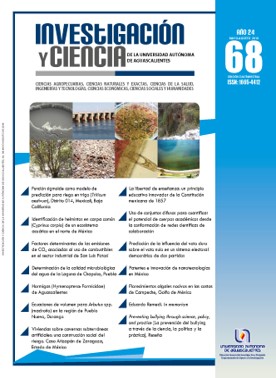Predicción de la influencia del voto duro sobre el voto nulo en un sistema electoral democrático de dos partidos
DOI:
https://doi.org/10.33064/iycuaa2016682252Palabras clave:
red de opinión, simulación, red de spin, voto duro, voto nulo, red electoralResumen
En este trabajo se analiza el efecto que podría ejercer el voto duro sobre el voto nulo en un sistema electoral de dos partidos, mediante la introducción de una red de opinión con agentes activos (nodos) distribuidos uniformemente en su estado inicial con un valor denominado spin . Los dos primeros valores, llamados votos duros, representan a los simpatizantes incondicionales de una corriente política elegida; el último representa a los votantes inactivos o indecisos, los cuales podrían cambiar a por las interacciones con sus cuatro conocidos más cercanos, denominados 4-vecinos. Se realizaron tres estudios: primero se analizó la relación de la concentración final de agentes activos con respecto a su cantidad inicial, posteriormente se observó la proporción final de agentes inactivos con respecto a la proporción inicial de agentes activos, finalmente se observa la evolución del sistema en relación con el número de ciclos que transcurren para alcanzar la estabilidad.
Descargas
Citas
• ALDRICH, J. H. Why Parties? The Origin and Transformation of Political Parties in America. Chicago, US: The University of Chicago Press, 1995.
• ALESINA, A. y SPEAR, S. E. An Overlapping Generation Model of Electoral Competition. Journal of Public Economics, 37(3): 359-379, 1988.
• BALANKIN, A. S. et al. Effect of initial concentration and spatial heterogeneity of active agent distribution on opinion dynamics. Physica A: Statistical Mechanics and its Applications, 390(21): 3876-3887, 2011.
• CHEN, P. y REDNER, S. Majority rule dynamics in finite dimensions. Physical Review E, 71(3): 036101, 2005.
• GALAM, S. Application of statistical physics to politics. Physica A, 274, 132-139, 1999.
• GIDDENS, A. Más allá de la izquierda y la derecha: El futuro de las políticas radicales. Madrid, España: Cátedra, 1996.
• HUANG, G. et al. The strength of the minority. Physica A, 387, 4665-4672, 2008.
• KNOKE, D. y YANG, S. Social Network Analysis (Quantitative Applications in the Social Sciences). US: Sage Publications, 2008.
• LAMBIOTTE, R. et al. Majority model on a network with communities. Physical Review E, 75, 030101(R), 2007.
• LIJPHART, A. Electoral Systems and Party Systems: A study of twenty-seven Democracies 1945-1990. Oxford, UK: Oxford University Press, 1994.
• MAINWARING, S. y SCULLY, T. R. Introduction: Party Systems in Latin America. En S. Mainwaring & T. R. Scully (Eds.), Building Democratic Institutions: Party Systems in Latin America (1-34). Stanford, CA, US: Stanford University Press, 1995.
• MIROIU, A. Characterizing majority rule: from profiles to societies. Economics Letters, 85(3): 359-363, 2004.
• PABJAN, B. y PEKALSKI, A. Model of opinion forming and voting. Physica A, 38, 6183, 2008.
• POPKIN, S. L. The Reasoning Voter: Communication and Persuasion in Presidential Campaigns. Chicago, US: The University of Chicago Press, 1991.
• RAE, D. The Political Consequences of Electoral Laws. New Haven, Connecticut, US: Yale University Press, 1969.
• REGENWETTER, M. et al. A general concept of majority rule. Mathematical Social Sciences, 43(3): 405-428, 2002.
• ROSENBLUM, N. L. On the Side of the Angels: An Appreciation of Parties and Partisanship. Princeton, NJ, US: Princeton University Press, 2008.
• SIRVENT, C. y DELGADILLO, F. Realineamiento del voto y nuevo orden electoral 1997. El Nacional, p. 2, jueves 10 de abril de 1997.
• TIDEMAN, T. N. A Majority-Rule Characterization with Multiple Extensions. Social Choice and Welfare, 3(1): 17-30, 1986.
• TOIVONEN, R. et al. A comparative study of social network models: Network evolution models and nodal attribute models. Social Networks, 31(2009): 240-254, 2009.
• TRAVIESO, G. y COSTA, L. F. Spread of opinions and proportional voting. Physical Review E, 74, 036112, 2006.
• TSALLIS, C. A majority rule model: real space renormalization group solution and finite size scaling. Journal de Physique Letters France, 43, L471-L476, 1982.
• VILELA, A. L. M. y MOREIRA, F. G. B. Majority-vote model with different agents. Physica A: Statistical Mechanics and its Applications, 388(19): 4171-4178, 2009.
• WASSERMAN, S. y FAUST, K. Social Network Analysis: Methods and Applications. Cambridge, UK-NY, US: Cambridge University Press, 1994.
• WILHEIM, G. Democracy in the digital age: challenges to political life in cyberspace. NY, US-London, UK: Routledge, 2000.
Descargas
Publicado
Cómo citar
Licencia
Las obras publicadas en versión electrónica de la revista están bajo la licencia Creative Commons Atribución-NoComercial-CompartirIgual 4.0 Internacional (CC BY-NC-SA 4.0)









